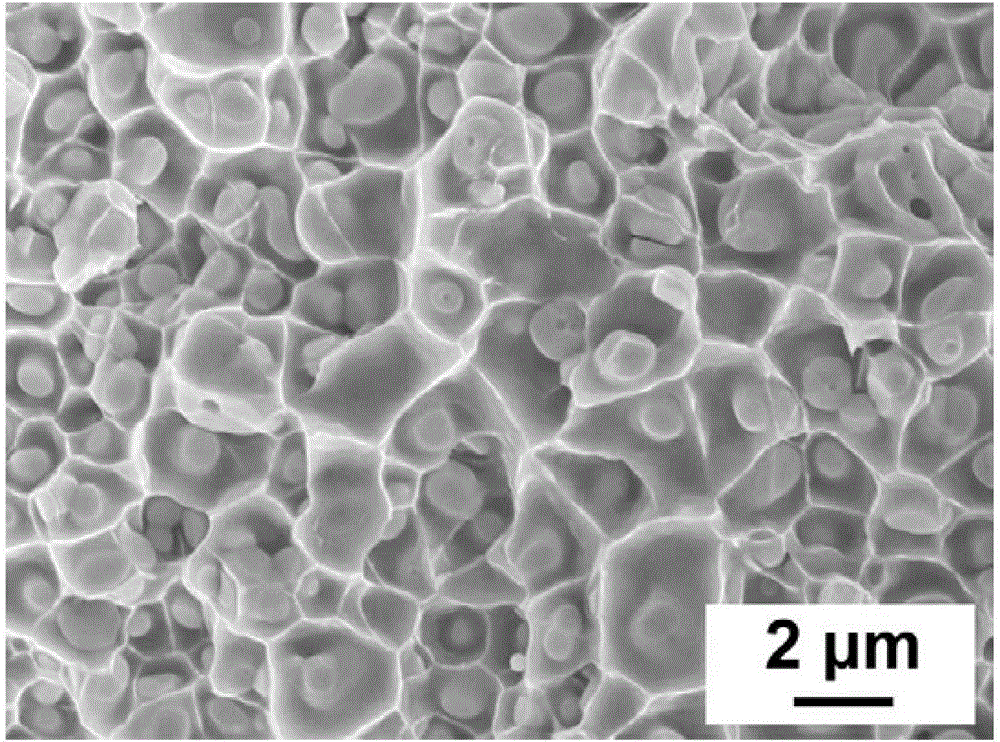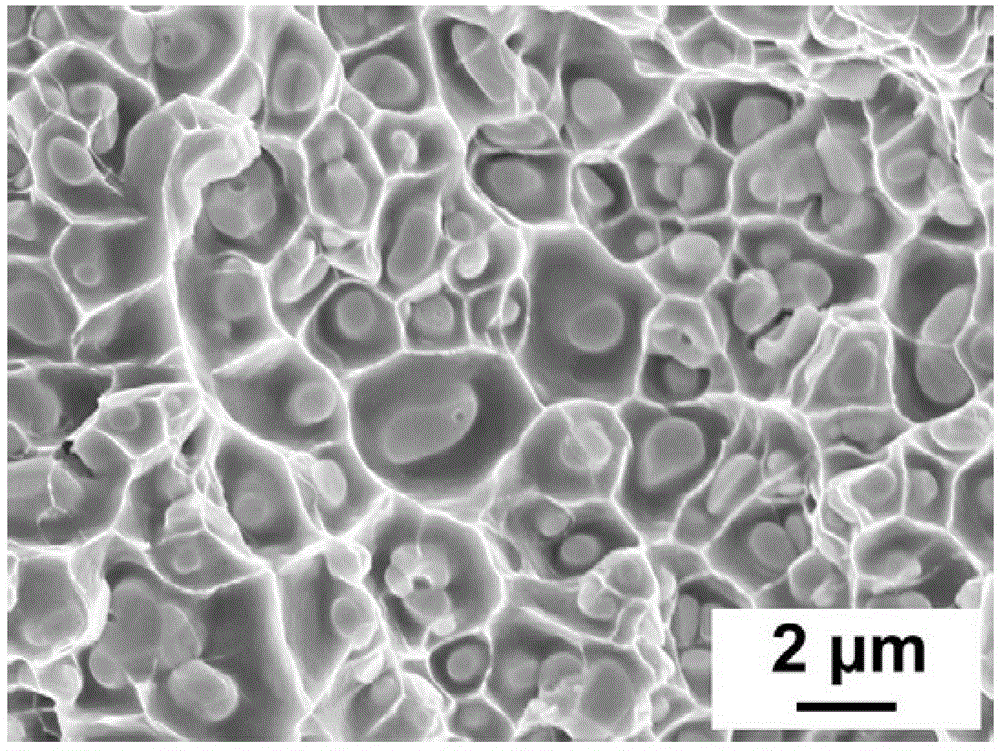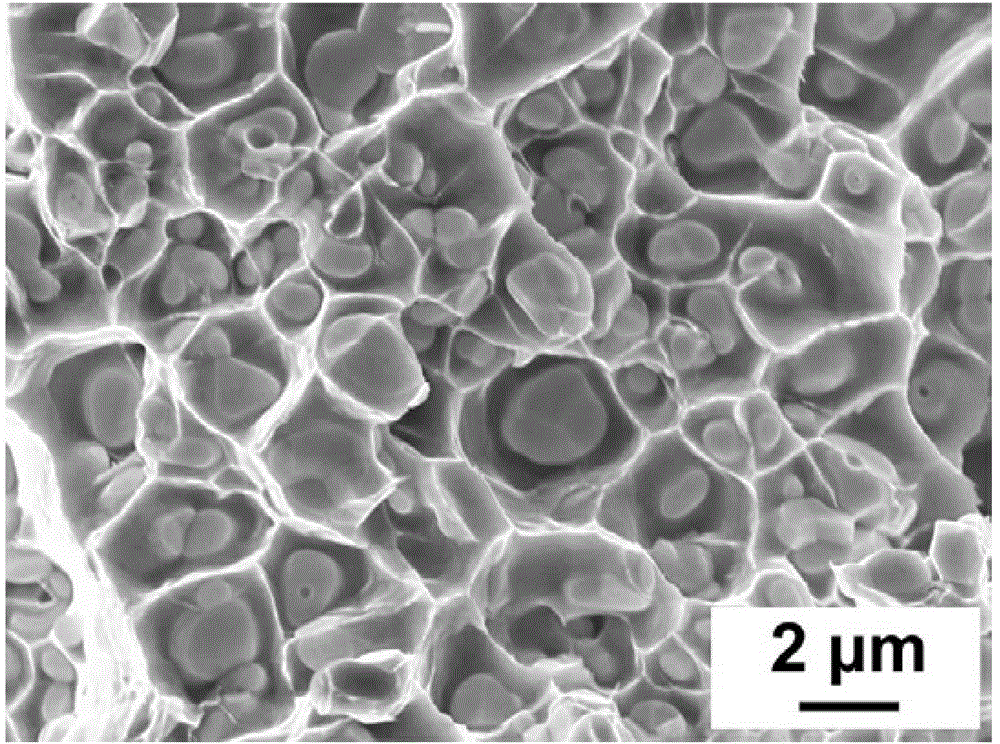Method for preparing tungsten-copper alloy by low-temperature sintering of tungsten skeleton
A tungsten-copper alloy, low-temperature sintering technology, applied in the field of preparation of tungsten-copper composite materials, can solve the problems of many closed pores, high sintering temperature, low relative density of tungsten-copper composite materials, etc., and achieves the effect of low cost and simple process
- Summary
- Abstract
- Description
- Claims
- Application Information
AI Technical Summary
Problems solved by technology
Method used
Image
Examples
Embodiment 1
[0024] Example 1: Preparation of tungsten-copper alloy with copper mass percentage of 25 and balance of tungsten
[0025] Using tungsten powder with a purity of 99.9% and a particle size of 2μm, and the powder used (tungsten powder + WO 2 ) WO with a total mass of 5wt.% and a particle size of 11.22μm x Put the powder into the ball mill, add a small amount of cemented carbide balls and alcohol, mix for 6 hours until the mixture is uniform, and sieve the mixed powder with 80 mesh after drying. The mixed powder was isostatically pressed under a pressure of 160 MPa and then molded, and the obtained compact was placed in a hydrogen furnace for sintering at a sintering temperature of 1400° C. and kept for 2 hours to obtain a tungsten skeleton. After cooling and reclaiming, the porosity λ of the tungsten skeleton was determined to be 57.5%, and then the copper infiltration amount was calculated. The actual copper infiltration amount is 1.1 times the calculated amount, and the pur...
Embodiment 2
[0028] Example 2: Preparation of tungsten-copper alloy with copper mass percentage of 30 and balance of tungsten
[0029] Using tungsten powder with a purity of 99.9% and a particle size of 2μm, and the powder used (tungsten powder + WO 2 ) WO with a total mass of 10wt.% and a particle size of 11.22μm x Put the powder into the ball mill, add a small amount of cemented carbide balls and alcohol, mix for 6 hours until the mixture is uniform, and sieve the mixed powder with 80 mesh after drying. The mixed powder was isostatically pressed under a pressure of 160 MPa and then molded, and the obtained compact was placed in a hydrogen furnace for sintering at a sintering temperature of 1400° C. and kept for 2 hours to obtain a tungsten skeleton. After cooling and reclaiming, the porosity λ of the tungsten skeleton was determined to be 50.54%, and then the copper infiltration amount was calculated. The actual copper infiltration amount is 1.1 times the calculated amount, and the p...
Embodiment 3
[0032] Example 3: Preparation of tungsten-copper alloy with copper mass percentage of 35 and balance of tungsten
[0033] Using tungsten powder with a purity of 99.9% and a particle size of 2μm, and the powder used (tungsten powder + WO 2 ) WO with a total mass of 15wt.% and a particle size of 11.22μm x Put the powder into the ball mill, add a small amount of cemented carbide balls and alcohol, mix for 6 hours until the mixture is uniform, and sieve the mixed powder with 80 mesh after drying. The mixed powder was isostatically pressed under a pressure of 160 MPa and then molded, and the obtained compact was placed in a hydrogen furnace for sintering at a sintering temperature of 1400° C. and kept for 2 hours to obtain a tungsten skeleton. After cooling and reclaiming, the porosity λ of the tungsten skeleton was determined to be 46.63%, and then the copper infiltration amount was calculated. The actual copper infiltration amount is 1.1 times the calculated amount. The pure ...
PUM
| Property | Measurement | Unit |
|---|---|---|
| purity | aaaaa | aaaaa |
| particle size | aaaaa | aaaaa |
| density | aaaaa | aaaaa |
Abstract
Description
Claims
Application Information
 Login to View More
Login to View More - R&D Engineer
- R&D Manager
- IP Professional
- Industry Leading Data Capabilities
- Powerful AI technology
- Patent DNA Extraction
Browse by: Latest US Patents, China's latest patents, Technical Efficacy Thesaurus, Application Domain, Technology Topic, Popular Technical Reports.
© 2024 PatSnap. All rights reserved.Legal|Privacy policy|Modern Slavery Act Transparency Statement|Sitemap|About US| Contact US: help@patsnap.com










